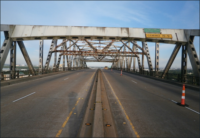Resident engineers from Krech Ojard & Associates, Hermitage, Pa., were on site around the clock to oversee the work and design alternatives as needed. Other key offsite team members, including design consultants from San Francisco-based URS Corp., remained on call to review any change orders.
Due to the compressed time line of dive operations, all of the major fixtures—including stainless steel valves, trash racks, gates and spools—were prefabricated based on the piecemeal construction drawings and assumptions that the tunnels were relatively straight.
Divers discovered otherwise, however. “The actual field conditions weren't the same as what the drawings depicted,” says A.W. McAfee, one of the divers on the project. “The tunnels were all slightly curved, with rock overhangs in places where we needed clearance.”
Each tunnel was unique and posed its own challenges, according to Gordon F. Harbison, resident engineer with Krech Ojard & Associates. To some degree, each of the outlets had to be reshaped to accept the spool pieces to which the valves were mounted.
The largest change order was at the lower level, where divers discovered the inlet was not natural rock but a mix of masonry rubble and concrete. “The original workers built the portal out to meet the valve, and the rubble they created did not have the structural properties to hold the spool in place,” Harbison says.
Divers had to excavate the area and enlarge the opening to push the spool back into the tunnel where it could be anchored to solid rock. The $1.4-million change order meant three additional underwater blasts and an extra 18 days of work.
Protecting Habitat
Reshaping the tunnels required a total of nine blasts, carried out with a blast-bag protection system developed by Global Diving & Salvage from heavy-duty vinyl fabric typically used for salvaging sunken vessels.
“The fabric molds to the contours of the rock and essentially forms pillows that contain the blast and dissipate the energy,” says John Ventress, project manager with Global Diving & Salvage. “The system prevents damage to the downstream habitat.”
Despite $2.2 million in change orders, the project had no lost production or standby charges, Martin says. Dive work—which accounted for about $10 million of phase one's $12.7-million budget—finished on schedule, with substantial completion in early November.
Installation of new valves will allow the outlets to be sealed and drained, permitting tunnel work to be completed during the second phase. Workers now can gain access to waterway tunnels through portals on the dam's downstream face.
Starting later this spring, seven gate valves within the primary outlet works will be decommissioned and abandoned in place. At the auxiliary level outlet, the needle valve and the upstream slide gate will be removed and replaced with a new jet-flow gate.
Completion is scheduled for spring 2012.
Article toolbar

